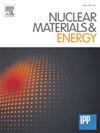Optimization and evaluation of a water-cooled target probe in linear plasma devices by computational fluid dynamics methods
IF 2.7
2区 物理与天体物理
Q1 NUCLEAR SCIENCE & TECHNOLOGY
引用次数: 0
Abstract
Effective cooling of the target probe under extreme plasma operational conditions is crucial for ensuring stable and reliable diagnostic measurements. In this study, we designed a water-cooled target probe specifically tailored for deployment in a linear plasma device (LPD). Computational Fluid Dynamics (CFD) methods were employed to evaluate and optimize the cooling performance of the target probe. CFD simulations included different probe base structures and inlet pipe types. The trade-offs between enhanced heat transfer and the associated pressure drop losses for different inlet pipe designs have been comprehensively considered. Simulation results indicated that at a Gaussian heat load of 10 MW/m2, which simulates a plasma discharge scenario in the LPD, the maximum temperature of the tungsten probe tip for the optimized target probe was reduced to approximately 723 ℃. Extending the thermal analysis to a future scenario where the target probe is subjected to three adjacent plasma beams, the temperature increase of the tungsten probe tips was not significant. This robust cooling performance highlights the potential of the target probe for application in advanced linear plasma devices that feature multiple or multichannel plasma sources.
基于计算流体动力学方法的线性等离子体装置水冷目标探针优化与评价
在极端等离子体操作条件下,目标探针的有效冷却对于确保稳定可靠的诊断测量至关重要。在这项研究中,我们设计了一种专门用于线性等离子体器件(LPD)部署的水冷靶探针。采用计算流体动力学(CFD)方法对目标探针的冷却性能进行了评价和优化。CFD模拟包括不同的探头底座结构和进气管类型。综合考虑了不同进气管设计的强化传热和相关压降损失之间的权衡。仿真结果表明,在10 MW/m2的高斯热负荷下,在模拟等离子体放电场景下,优化后的目标探针的钨探针尖端最高温度降至723℃左右。将热分析扩展到未来的场景,即目标探针受到三个相邻的等离子束,钨探针尖端的温度升高并不显著。这种强大的冷却性能突出了目标探针在具有多通道或多通道等离子体源的先进线性等离子体器件中的应用潜力。
本文章由计算机程序翻译,如有差异,请以英文原文为准。
求助全文
约1分钟内获得全文
求助全文
来源期刊

Nuclear Materials and Energy
Materials Science-Materials Science (miscellaneous)
CiteScore
3.70
自引率
15.40%
发文量
175
审稿时长
20 weeks
期刊介绍:
The open-access journal Nuclear Materials and Energy is devoted to the growing field of research for material application in the production of nuclear energy. Nuclear Materials and Energy publishes original research articles of up to 6 pages in length.
 求助内容:
求助内容: 应助结果提醒方式:
应助结果提醒方式:


